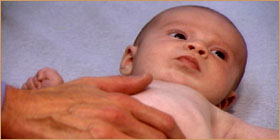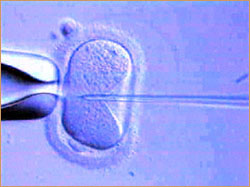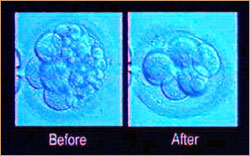|

|

|
|
|
 "Eighteen ways to make me? I'm speechless."
"Eighteen ways to make me? I'm speechless."
|
The 18 Ways (And Then Some)
by Sarah Holt
When I first heard there were 18 ways to make a baby, I was
flabbergasted. Dr. Jamie Grifo, a specialist in reproductive
endocrinology at New York University Medical Center,
casually mentioned the fact in an interview that I taped
with him for this NOVA program.
Imagine my amazement when I learned that there were actually
many more than 18.
Before producing the film, I probably would have been
surprised to hear there were more than three or four. Like
most people, I was familiar with artificial insemination and
in vitro fertilization and frozen embryos, but not much
more. While working on the program, I had come to have a
layperson's understanding of some of the latest techniques,
which have futuristic names like Intra-Cytoplasmic Sperm
Injection and Preimplantation Genetic Diagnosis.
Nevertheless, I was initially hard-pressed to come up with
18 ways.
Eventually I did, and I ran the list past Dr. Grifo to
ensure it was accurate. It was, and here it is.
Note: Click on highlighted terms for a definition.
- Natural sex
-
Artificial insemination—of mother with father's sperm
-
Artificial insemination—of mother with donor sperm
-
Artificial insemination—with egg and sperm donors,
using surrogate mother
-
In vitro fertilization (IVF)—using egg and sperm of parents
-
IVF—with
Intra-Cytoplasmic Sperm Injection (ICSI)
-
IVF—with
frozen embryos
-
IVF—with
Preimplantation Genetic Diagnosis (PGD)
- IVF—with egg donor
- IVF—with sperm donor
- IVF—with egg and sperm donor
-
IVF—with
surrogate
using parents' egg and sperm
- IVF—with surrogate and egg donor
- IVF—with surrogate and sperm donor
-
IVF—with surrogate using her egg, sperm from
baby's father
-
IVF—with surrogate using egg and sperm donors*
-
Cytoplasmic transfer**
-
Nuclear transfer
and
cloning
*In this case, the newborn essentially has five parents:
the birth parents who provided the egg and sperm, the
surrogate mother who carried the baby, and the parents who
will raise the baby.
**The U.S. Food and Drug Administration has recently asked
the specialists that perform this experimental procedure
to submit it for FDA approval, so it is currently not
available.
 #17 on Jamie Grifo's list.
#17 on Jamie Grifo's list.
|
|
Now, since we had decided to use "18 Ways" in the title, I
wanted to make absolutely sure this was an accepted list.
Could PGD be considered a way to make a baby or merely a
test performed before choosing a way? Should nuclear
transfer and cloning be on the list? After all, they had
produced animal babies but as yet no human babies. Another
call to Dr. Grifo revealed that he stood by his list.
To be safe, I emailed the list to other specialists, and
they came up with yet more ways to make a baby. Dr. Douglas
Powers, scientific and laboratory director at Boston IVF, a
fertility and IVF center, said that if you paired ICSI with
numbers 12 through 16 on Grifo's list, you'd have five more
ways. That brought us to 23.
Dr. Jacques Cohen, scientific director of the Institute for
Reproductive Medicine and Science at Saint Barnabas Medical
Center in Livingston, New Jersey, fired back an email in
which he said "There are many more ways of making babies
than 18. Can I add some more?" He listed several techniques
that add to those mentioned by Grifo and Powers, and here
they are, edited for clarity and numbered
appropriately:
-
Assisted hatching: IVF or ICSI and opening the zona
pellucida (embryo shell) to help the embryo hatch and
increase its chances of successful implantation into the
lining of the uterus.
|
 #25 on Jacques Cohen's list.
#25 on Jacques Cohen's list.
|
-
Fragment removal: In addition to the procedure
described in #24, removing from around the embryo's
cells adverse fragments of cell debris, which are
thought to possibly impair the development of the
embryo.
-
Co-culture: Culturing the embryos on cells from the
woman's reproductive tract (fallopian tubes and uterus).
Helps reduce cytoplasmic fragments (see #25) and improve
embryo quality.
-
Testicular Sperm Aspiration (TESA): Obtaining sperm for
fertilization from men who previously were thought to
have no sperm (azoospermic men) by extracting the cells
from the testicle.
-
Single sperm freezing: By freezing one sperm cell in an
empty shell of an animal egg so it can be retrieved
after thaw. This is done for TESA (see #27) when there
are only a few detectable spermatozoa, and the TESA was
exploratory, so the egg collection can be dealt with
later.
-
After maturing unripe eggs in vitro.
-
After freezing the unfertilized eggs.
At the end of his list, Cohen added "etc., etc."
Clearly, 18 is an arbitrary figure. Suffice it to say that
couples who cannot conceive naturally have a doctor's bag
full of potential options to choose from. Though they should
choose carefully, specialists in the field stress. "While
there are many ways one can produce a baby, one should
always consider them in the context of their safety and
efficacy," says Dr. Zev Rosenwaks of Cornell University.
"This implies not only safeguarding against medical risks
but also paying great attention to the emotional and social
manifestations of the procedures involved." (For more
information on assisted reproduction, see
Resources.)
Sarah Holt produced the NOVA program "18 Ways to Make a
Baby."
Photos: WGBH/NOVA
The 18 Ways (And Then Some)
|
On Human Cloning
|
Fertility Throughout Life
|
How Cells Divide
Resources
|
Teacher's Guide
|
Transcript
|
Site Map
|
18 Ways to Make a Baby Home
Search |
Site Map
|
Previously Featured
|
Schedule
|
Feedback |
Teachers |
Shop
Join Us/E-Mail
| About NOVA |
Editor's Picks
|
Watch NOVAs online
|
To print
PBS Online |
NOVA Online |
WGBH
©
| Updated October 2001
|
|
|
|